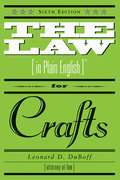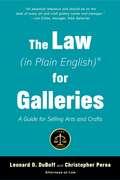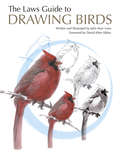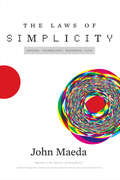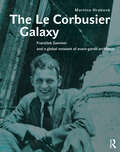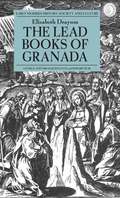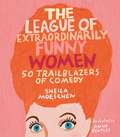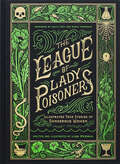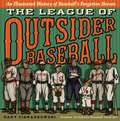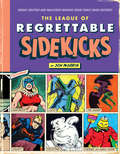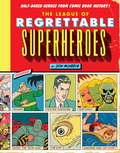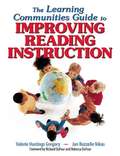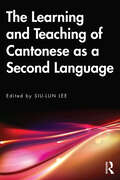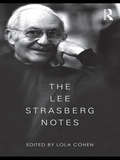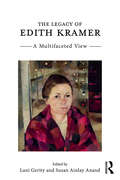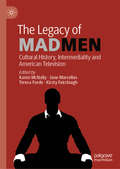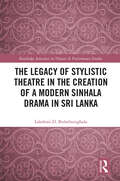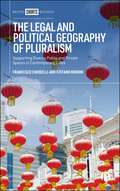- Table View
- List View
The Law School at the University of Virginia: Architectural Expansion in the Realm of Thomas Jefferson
by Philip Mills HerringtonAs a UNESCO World Heritage Site and a masterwork of Thomas Jefferson, the "Academical Village" at the heart of the University of Virginia has long attracted the attention of visitors and scholars alike. Yet today Jefferson’s original structures make up only a small fraction of a campus comprising over 1,600 acres. The Law School at the University of Virginia traces the history of one of the eight original schools of the University to study the development of the University Grounds over nearly two hundred years. In this book, Philip Mills Herrington relates the remarkable story of how the Law School and the University have used architecture to reconcile a desire for progress with a veneration for the past. In addition to providing a fascinating history of one of the oldest and most influential law schools in the United States, Herrington offers a valuable case study of the ways in which American universities have constructed, altered, and enhanced the built environment in response to the ever-changing demands of higher education and campus life.
The Law in Plain English for Crafts: Sixth Edition
by Leonard D. DuboffHere is the definitive guide for craftspeople who want to successfully tackle the business and legal issues they face every day. Explanations of new laws
The Law: A Guide for Lovers of Art and Antiques (In Plain English)
by Leonard DuBoff Sarah Tugman“Savvy art collectors who want to protect themselves and their investments would be wise to read The Law (in Plain English)® for Collectors. The book provides valuable guidance that collectors of all levels can rely on.” —Dale Chihuly In The Law (in Plain English)® for Collectors, Leonard DuBoff and Sarah Tugman provide helpful advice on all things legal when it comes to art, antiques, and other collectibles. Whether readers are into coins or Queen Anne furniture, paintings or vintage books, this guide contains useful and practical information readers need to know to protect and enjoy their collections. Among other important concerns, readers will learn how to: Navigate purchases and customs Select insurance plans Properly file taxes Loan out pieces to galleries, museums, and shows Bestow work to future generations For private collectors, gallerists, artists, and others interested in art dealings, The Law (in Plain English)® for Collectors is an indispensable reference.
The Law: A Guide for Selling Arts and Crafts (In Plain English)
by Leonard D. DuBoff Christopher PereaAn Essential Reference for Sellers of Arts and Crafts In The Law (in Plain English)® for Galleries, Third Edition, Leonard DuBoff and Christopher Perea walk readers through the legal intricacies of selling arts and crafts. This helpful guide provides clear explanations and examples of real cases to furnish readers with a strong understanding of their obligations and vulnerabilities. Updated to reflect recent changes in the market and technology, this new edition is the go-to guide for all aspects of running a gallery. Chapters cover a wide range of topics, including: Organizing a businessFranchisingWorking with employees and contractorsSelling piecesContractsArtists&’ and galleries&’ rightsCatalogs and online salesCopyright and trademarkCustomer relationsProduct liabilityFiling taxesEstate planning Gallerists, artists, craftspeople, and anyone else interested in the buying and selling of arts and crafts must have this book in their libraries.
The Laws Guide to Drawing Birds
by John Muir LawsJohn Muir Laws’s guide to drawing birds is itself winged, soaring between a devotion not only to art but also to the lives, forms, and postures of the birds themselves. Here, artistic technique and the exquisite details of natural history intertwine, and drawing becomes the vehicle for seeing. As Laws writes, “To draw feathers, you must understand how feathers grow, overlap, and insert into the body. To create the body, you must have an understanding of the bird’s skeletal structure. To pose this skeleton, you must be able to perceive the energy, intention, and life of the bird.” This how-to guide will perfect the technique of serious arists but also, perhaps more importantly, it will provide guidance for those who insist they can’t draw. Leading the mind and hand through a series of detailed exercises, Laws delivers what he promises: that “drawing birds opens you to the beauty of the world.” An Audubon Book.
The Laws of Fesole: Principles of Drawing and Painting from the Tuscan Masters
by John RuskinWith the aging of Postmodernism, artists and academics are reappraising the aesthetics of Modernism. In this timeless classic, Ruskin offers criticism, appreciation, and instruction for artists at the very beginnings of the Modern movement.“As vital and relevant today as it was over a hundred years ago. This timeless classic, now back in print, will introduce a whole new generation of readers and art lovers to the analytic genius of John Ruskin.”—The Bookwatch, October, 1996“As we read Ruskin's art criticism we find revealing and stimulating insights into the early beginnings of the Modern movement....As we read Beckley's annotations we can revisit 19th-century art criticism with greater detachment.”—Arts & Activities, March, 1998“Ruskin's strength lies in his ability to absolutely commit to a concept, and translate that commitment into the written word. This attention to the craft of writing makes it possible for Ruskin to propound several divergent themes in one text and allow for the inconsistencies (because the structure is consistent and can contain the thoughts) inevitable in such a breadth of inquiry....it is his poetic evocation of self-purpose and his refusal to apologize for deeply held beliefs that make his writing so enriching... .”—New Art Examiner, March, 1997“This isn't a discourse on how to paint or a treatise on art history, but a critical examination of painting at the beginnings of the Modern movement. This approach provides artists and students with guidelines for assessing work of the period, and this edition includes over forty black-and-white illustrative examples and a new introduction by artist Bill Beckley. An excellent examination of forms, sense, and artistic license.”—The Midwest Book Review
The Laws of Simplicity: Design, Technology, Business, Life
by John MaedaTen laws of simplicity for business, technology, and design that teach us how to need less but get more. Finally, we are learning that simplicity equals sanity. We're rebelling against technology that's too complicated, DVD players with too many menus, and software accompanied by 75-megabyte "read me" manuals. The iPod's clean gadgetry has made simplicity hip. But sometimes we find ourselves caught up in the simplicity paradox: we want something that's simple and easy to use, but also does all the complex things we might ever want it to do. In The Laws of Simplicity, John Maeda offers ten laws for balancing simplicity and complexity in business, technology, and design—guidelines for needing less and actually getting more. Maeda—a professor in MIT's Media Lab and a world-renowned graphic designer—explores the question of how we can redefine the notion of "improved" so that it doesn't always mean something more, something added on.Maeda's first law of simplicity is "Reduce." It's not necessarily beneficial to add technology features just because we can. And the features that we do have must be organized (Law 2) in a sensible hierarchy so users aren't distracted by features and functions they don't need. But simplicity is not less just for the sake of less. Skip ahead to Law 9: "Failure: Accept the fact that some things can never be made simple." Maeda's concise guide to simplicity in the digital age shows us how this idea can be a cornerstone of organizations and their products—how it can drive both business and technology. We can learn to simplify without sacrificing comfort and meaning, and we can achieve the balance described in Law 10. This law, which Maeda calls "The One," tells us: "Simplicity is about subtracting the obvious, and adding the meaningful."
The Lay of the Land: A Self-Taught Photographer's Journey to Find Faith, Love, and Happiness
by Joe GreerA spiritually uplifting and beautiful designed visual memoir by the hugely popular photographer on Instagram, Joe Greer, combining thoughtful essays and more than 100 gorgeous landscape photos—half fan favorites, and half never-before-seen.“Each photograph really does come down to a split second when you decide to freeze that moment in time. . . . You ask yourself what the story is that you want to tell, and let the rest unfold: Click.”—from the introductionJoe Greer never imagined he would become a photographer. Raised in Florida by an aunt and uncle after his mother’s death when he was four, Joe had a seemingly normal childhood, spending summers at church camp and dreaming of going to college. But nearly fifteen years later, the ground shifted beneath his feet when he discovered a family secret that would impact the rest of his life.Trying to make sense of that revelation and what it meant for his future, Greer set his sights on becoming a pastor at Spokane’s Moody Bible Institute. There, he discovered Instagram—and a passion for photography. His pictures of the lush, wild beauty of the Pacific Northwest landscape attracted a large following that has grown to more than three quarters of a millions fans and continues to expand. The Lay of the Land is Joe’s story in words and pictures. In this stunning compendium, he reflects on the trauma of his early life and what photography has taught him: how to find his light; how to slow down; how to appreciate the world around him, a reverence for the nature world that that both nurtures and amplifies his creativity and faith; how to love—his photography led him to his wife, Madison—and how to heal. For Joe, photography has been a way to find purpose, better understand his faith, and express himself. Though he began with landscapes, meeting his wife sparked a new love of portraiture, and he turned to making photos of street scenes that explored his complicated feelings about family. A love letter to the natural world, to faith, and to finding your calling in the most unexpected places, The Lay of the Land is a window into the beautiful mind and heart of one of the internet’s favorite photographers. Moving and inspiring, it is a creative and spiritual journey that offers lessons on life and living. As Greer reminds us all, whatever it is you want, it’s up to you to make the moment (and the photograph).
The Le Corbusier Galaxy: František Sammer and a global network of avant-garde architects
by Martina HrabováDrawing on the author‘s discovery of an unknown, long-forgotten collection of photographs in an Indian ashram, this book offers an exciting, new view of the international community of young architects who served as Le Corbusier‘s assistants in the inter-war years. A collection of some 500 snapshots, assembled by the Czech architect František Sammer between 1931 and 1939, had been stored unnoticed for more than 70 years in an unlikely location – the Sri Aurobindo Ashram in Pondicherry, India. Sammer was one of Le Corbusier‘s closest assistants from the early 1930s. Later, Sammer worked in the Soviet Union, Japan and India. During, and after, his time in Paris, he personally took or collected these photographs, which he then deposited at the ashram when he left to fight in World War II. The images offer a remarkable view of the international community of people who worked in Le Corbusier’s atelier in the 1930s. Among those featured in the photographs are Charlotte Perriand, Pierre Jeanneret, Jane West (the first American woman to work for Le Corbusier), Gordon Stephenson, Antonin Raymond, Junzo Sakakura and Josep Lluís Sert. Given the travels and international background of these individuals, the photographs are from different countries around the world, including the USSR, England, France, Czech Republic, Greece, USA (Tennessee, Montana, California and New Mexico), Japan and India. The Le Corbusier Galaxy successfully brings together serious archival research with a fascinating narrative, and it captures the human dimension of modern architecture, which is all too often neglected in today’s accounts.
The Lead Books of Granada
by Elizabeth DraysonHailed as early Christian texts as important as the Dead Sea Scrolls, yet condemned by the Vatican as Islamic heresies, the Lead books of Granada, written on discs of lead and unearthed on a Granadan hillside, weave a mysterious tale of duplicity and daring set in the religious crucible of sixteenth-century Spain. This book evaluates the cultural status and importance of these polyvalent, ambiguous artefacts which embody many of the dualities and paradoxes inherent in the racial and religious dilemmas of Early Modern Spain. Using the words of key individuals, and set against the background of conflict between Spanish Christians and Moriscos in the late fifteen-hundreds, The Lead Books of Granada tells a story of resilient resistance and creative ingenuity in the face of impossibly powerful negative forces, a resistance embodied by a small group of courageous, idealistic men who lived a double life in Granada just before the expulsion of the Moriscos.
The League of Extraordinarily Funny Women: 50 Trailblazers of Comedy
by Sheila MoeschenA celebration of the most groundbreaking women in comedy who used humor to shake up the status quo and change perceptions of gender and comedy forever.The League of Extraordinarily Funny Women celebrates the outstanding contributions of fifty women in comedy past and present. From legends like Lucille Ball, Joan Rivers, and Tina Fey to current comedy heroes like Issa Rae, Lena Waithe, Abbi Jacobson, and Tig Notaro, this beautifully illustrated book charts a rich lineage of women using humor to speak truth to power, tangle with sensitive subjects, challenge the status quo, and do anything but sit still and stay quiet when laughs are on the line.Some of these women broke boundaries as pioneers on stage as well as in front of and behind the camera. Others penned their way into the history of American humor, redrawing the boundaries of writers' rooms to include diverse voices and perspectives. Through their collective work as stand-ups, sketch and improv comics, humor writers, and slapstick film stars, these women formed a network forged by creativity, guts, and a deep love of what comedy can do and be. In the process, they continue to pass their knowledge and insights from woman to woman, from funny generation to funny generation, offering support, inspiration, and, above all, laughter.
The League of Lady Poisoners: Illustrated True Stories of Dangerous Women
by Lisa PerrinA feast for the senses, this sumptuously illustrated book will introduce you to some of the most infamous women throughout world history, united by their shared taste for poison. Welcome to the League of Lady Poisoners.This riveting and well-researched volume by Lisa Perrin weaves together the stories of more than twenty-five accused women poisoners, exploring the circumstances and skill sets that led them to lives of crime.You might find yourself rooting for some of them—like Sally Bassett, who helped poison her granddaughter's enslavers in Bermuda, or Giulia Tofana, who sold her name-brand concoction to women wanting to be rid of their abusive (or otherwise undesirable) husbands. Other stories, though—including that of Yiya Murano, one of Argentina's most notorious swindlers and serial killers, or the terrifying Nurse Jane Toppan—may prove less palatable.Organized into thematic chapters based on the women's motives, the book also includes an illustrated primer that delves into the origins and effects of common poisons throughout history, as well as a foreword by Holly Frey and Maria Trimarchi, creators and hosts of the podcast Criminalia. It is a treat for true crime fans, feminist history buffs, and any curious readers fascinated by the more macabre side of human nature.TRUE CRIME GALORE: Women can do anything—even commit murder. This thoughtfully researched and insightful survey into the lives of the poisoners explores the toxic events that put these women in the spotlight, the deceptive methods and substances they used, and their legacies today. The League of Lady Poisoners is a thrilling deep dive for fans of true crime podcasts, docuseries, and books.EYE-CATCHING GIFT: Illustrator and author Lisa Perrin's beautiful and distinctive art style blends the romantic allure of these pop culture legends with the disturbing and twisted facts of their lives. The hardcover is decorated with shining foil, and the interior contains clever Victorian-inspired lettering, borders, and diagrams that complement the text. Readers and illustrated book collectors will love all the details honoring the Golden Age of Poison. FASCINATING, DIVERSE STORIES OF WOMEN WHO KILL: These women lived in different time periods and had varying cultural and socioeconomic backgrounds that influenced their motives. Some acted out of defiance—like the Angel Makers of Nagyrév, who taught women how to dispose of their abusive husbands in Hungary. Others schemed their way to power and money, including Empress Wu Zetian of China and Belle Gunness, who killed more than 14 people in the American Midwest. Discover all their stories in this engaging collection . . . if you have the stomach for them.Perfect for:Lovers of true crime podcasts like My Favorite Murder, Morbid, and CriminaliaReaders who enjoy historical biographies, especially of womenReaders who love a good villain, antihero, or underdog storyMurder mystery fansArt lovers and illustrated book collectorsFans of Lisa Perrin's beautiful illustrationShoppers looking for a unique feminist gift bookFans of period dramas like The Serpent Queen and The BorgiasReaders who enjoy books like Lady Killers: Deadly Women Throughout History and The Trial of Lizzie Borden
The League of Outsider Baseball
by Gary Cieradkowski<p>From an award-winning graphic artist and baseball historian comes a strikingly original illustrated history of baseball's forgotten heroes, including stars of the Negro Leagues, barnstorming teams, semi-pro leagues, foreign leagues, and famous players like Shoeless Joe Jackson, Jackie Robinson, Willie Mays, and Joe DiMaggio before they achieved notoriety. <p>From a young age, Gary Cieradkowski had a passion for baseball's unheralded heroes. Inspired by his father and their shared love of the sport, Cieradkowski began creating "outsider" baseball cards, as a way to tell the little-known stories of baseball's many unsung heroes--alongside some of baseball's greatest players before they were famous. <i>The League of Outsider Baseball</i> is a tribute to all of those who've played the game, known and unknown. <p>Shining a light into the dark corners of baseball history--from Mickey Mantle's minor league days to Negro League greats like Josh Gibson and Leon Day; to people that most never knew played the game, such as Frank Sinatra, who had his own ball club in 1940s Hollywood; bank robber John Dillinger, who was a promising shortstop and took time out between robberies to attend Cubs games; and even a few US presidents--this book is a rich, visual tribute to America's pastime. <p>Meticulously researched, beautifully illustrated using a unique, vintage baseball-card-style, and filled with a colorful and rich cast of characters, this book is a prized collector's item and will be cherished by fans of all ages.
The League of Regrettable Sidekicks: Heroic Helpers from Comic Book History! (Comic Book History #4)
by Jon MorrisA hilarious spotlight on the strangest second bananas in superhero comics, including junior partners, animal assistants, and even heinous henchmen (sidekicks of the villain world). Complete with vintage art and publication details.Batman has Robin. Captain America has Bucky. And Yankee Doodle had Dandy.Being a superhero is hard work, which is why so many comics characters rely on a sidekick for help. Someone who can watch the hero's back, help search for clues, or, if nothing else, give the hero someone to talk to. But just as not every superhero achieves the glory of Batman, not all sidekicks are as capable as the Boy Wonder. In The League of Regrettable Sidekicks, author Jon Morris discusses some of the strangest iterations of the sidekick phenomenon, and in the process explores how important these characters were to comic book storytelling. You'll meet plucky but forgotten helpers like Thunderfoot (explosive-soled assistant to the Human Bomb), heroic super-pets (like Frosting, polar bear pal of space hero Norge Benson), fan favorites (say hello to Rick Jones, sidekick to half of the Marvel Universe), and obscure partners of iconic heroes (Superman Junior's career barely got off the ground). Plus: pernicious profiles of regrettable henchmen and minions, the sidekicks of the supervillain world. Vintage art from the comics completes the experience.Drawing on the entire history of the medium, The League of Regrettable Sidekicks celebrates characters and stories that haven't seen the light of day in decades, pulling from defunct and long-forgotten comics publishers as well as DC and Marvel. In this third volume of his Regrettable series (The League of Regrettable Superheroes, The Legion of Regrettable Supervillains) Jon Morris provides insight and context, as well as his signature mockery of and affection for these overlooked treasures from comic book history.
The League of Regrettable Superheroes
by Jon MorrisYou know about Batman, Superman, and Spiderman, but have you heard of Doll Man, Doctor Hormone, or Spider Queen? In The League of Regrettable Superheroes, you'll meet one hundred of the strangest superheroes ever to see print, complete with backstories, vintage art, and colorful commentary. So prepare yourself for such not-ready-for-prime-time heroes as Bee Man (Batman, but with bees), the Clown (circus-themed crimebuster), the Eye (a giant, floating eyeball; just accept it), and many other oddballs and oddities. Drawing on the entire history of the medium, The League of Regrettable Superheroes will appeal to die-hard comics fans, casual comics readers, and anyone who enjoys peering into the stranger corners of pop culture.
The Learned Collector: Mythological Statuettes and Classical Taste in Late Antique Gaul
by Lea M. StirlingInspired by a classical education, wealthy Romans populated the glittering interiors of their villas and homes with marble statuettes of ancestors, emperors, gods, and mythological figures. In The Learned Collector, Lea M. Stirling shows how the literary education received by all aristocrats, pagan and Christian alike, was fundamental in shaping their artistic taste while demonstrating how that taste was considered an important marker of status. Surveying collections across the empire, Stirling examines different ways that sculptural collections expressed not only the wealth but the identity of their aristocratic owners. The majority of statues in late antique homes were heirlooms and antiques. Mythological statuary, which would be interpreted in varying degrees of complexity, favored themes reflecting aristocratic pastimes such as dining and hunting. The Learned Collector investigates the manufacture of these distinctive statuettes in the later fourth century, the reasons for their popularity, and their modes of display in Gaul and the empire. Although the destruction of ancient artwork looms large in the common view of late antiquity, statuary of mythological figures continued to be displayed and manufactured into the early fifth century. Stirling surveys the sculptural decor of late antique villas across the empire to reveal the universal and regional trends in the late antique confluence of literary education, mythological references, aristocratic mores, and classicizing taste. Deftly combining art historical, archaeological, and literary evidence, this book will be important to classicists and art historians alike. Stirling's accessible writing style makes this an important work for scholars, students, and anyone with an interest in Roman statues of this era.
The Learning Communities Guide to Improving Reading Instruction
by Valerie Hastings Gregory Jan Rozzelle NikasThe themes of attending to individual needs, providing assessment-driven instruction, and creating long-term, focused professional development plans are solid and consistent throughout.
The Learning and Teaching of Cantonese as a Second Language
by Siu-Lun LeeThe Learning and Teaching of Cantonese as a Second Language brings together contributions on such issues as Cantonese textbooks, linguistic description, literacy and tone acquisition, supplemented by case studies from the Netherlands and Japan. The learning and teaching of Cantonese as a second language is a subject of considerable interest in the international academic community, and the first international symposium on teaching Cantonese as a second language, held at the Chinese University of Hong Kong in October 2019, brought together leading researchers in this field. This conference provided the inspiration for the current volume, The Learning and Teaching of Cantonese as a Second Language. In the Hong Kong context, historically, the term ‘Cantonese’ refers to the language varieties of immigrants who came to the territory from various areas in Guangdong province, including Macau, Panyu, Taishan, Xinhui and Zhongshan. From the late nineteenth century onwards, their speech coalesced into the contemporary variety of Cantonese used in Hong Kong today. The term ‘Cantonese’ is also used to refer to the entire Yue subgroup of Chinese, which includes varieties of Cantonese spoken in southern China, Hong Kong, Macau, Malaysia, Singapore and among overseas Chinese in Australia, Europe and North America. In all, it is estimated that there are about 70 million Cantonese speakers in the world. This volume is of direct relevance to educators, language teachers, linguists and all those concerned with the learning of Cantonese as a second language.
The Leathercraft Handbook: 20 Unique Projects for Complete Beginners
by Candice LauDestined to be a classic, this modern introduction offers a contemporary twist on the age-old craft of leatherworking. The Leathercraft Handbook guides you through all the skills, tools, and techniques you need to make beautiful and durable pieces, from elegant accessories to stylish homewares - without the need for expensive equipment. Try your hand at more than 20 step-by-step projects, complete with easy-to-follow tutorials and templates that can be scaled up or down. Ranging from a classic glasses case to a chic tote bag, the pieces are suitable for beginners through to experienced leatherworkers and feature inspiration on how to make the designs your own.Use this tactile, age-old craft to make your own unique and modern leather items.
The Leathercraft Handbook: 20 Unique Projects for Complete Beginners
by Candice LauDestined to be a classic, this modern introduction offers a contemporary twist on the age-old craft of leatherworking. The Leathercraft Handbook guides you through all the skills, tools, and techniques you need to make beautiful and durable pieces, from elegant accessories to stylish homewares - without the need for expensive equipment. Try your hand at more than 20 step-by-step projects, complete with easy-to-follow tutorials and templates that can be scaled up or down. Ranging from a classic glasses case to a chic tote bag, the pieces are suitable for beginners through to experienced leatherworkers and feature inspiration on how to make the designs your own.Use this tactile, age-old craft to make your own unique and modern leather items.
The Lee Strasberg Notes
by Lola CohenThe Lee Strasberg Notes reproduces the original teachings of a unique voice in actor training, for the very first time. It is a stunning document in the history and ongoing practice of Strasberg’s Method. Compiled and edited by Lola Cohen, the book is based on unpublished transcripts of Strasberg’s own classes on acting, directing and Shakespeare. It recreates his theoretical approach, as well as the practical exercises used by his students, and brilliantly conveys his approach and personality. The book features Strasberg’s teachings on: • Training and exercises • Characters and scenes • Directing and the Method • Shakespeare and Stanislavski • The theater, acting and actors. Including a Preface by Anna Strasberg and a Foreword by Martin Sheen, this illuminating book brings the reader closer to Strasberg’s own methods than any other, making it a phenomenal resource for students, actors, and directors.
The Legacy of Edith Kramer: A Multifaceted View
by Lani Gerity Susan Ainlay AnandThe Legacy of Edith Kramer presents a unique exploration into the life and work of the groundbreaking artist and art therapist. This edited volume examines the artist’s personal and cultural history prior to relocating to the United States as well as the later years when she worked as an artist, art therapist, and teacher as she developed her theoretical understanding of art therapy. Kramer’s solutions to creating a meaningful artist’s life run throughout the chapters within this book, and provide the reader with a sense of what is possible. Written by an international group of contributors, this informative new text offers a multifaceted view of Edith Kramer that will be appreciated by current and future art therapists looking to better understand Kramer’s exceptional mind and contributions to the field.
The Legacy of Mad Men: Cultural History, Intermediality and American Television
by Kirsty Fairclough Karen McNally Jane Marcellus Teresa Forde“The Legacy of Mad Men adds significant new perspectives to the legacy of Mad Men scholarship. The authors apply theoretical perspectives that have been understudied in previous Mad Men work, chart new connections with previous media, and examine overlooked aspects of Men Men’s sound design. A concluding chapter insightfully considers how the election of Donald Trump has signaled a resurgence in the sexism, antisemitism, and racism critiqued in Mad Men.”- - Dr Jeremy Butler, Professor of Communication and Culture, University of Alabama For seven seasons, viewers worldwide watched as ad man Don Draper moved from adultery to self-discovery, secretary Peggy Olson became a take-no-prisoners businesswoman, object-of-the-gaze Joan Holloway developed a feminist consciousness, executive Roger Sterling tripped on LSD, and smarmy Pete Campbell became a surprisingly nice guy. Mad Men defined a pivotal moment for television, earning an enduring place in the medium’s history. This edited collection examines the enduringly popular television series as Mad Men still captivates audiences and scholars in its nuanced depiction of a complex decade. This is the first book to offer an analysis of Mad Men in its entirety, exploring the cyclical and episodic structure of the long form series and investigating issues of representation, power and social change. The collection establishes the show’s legacy in televisual terms, and brings it up to date through an examination of its cultural importance in the Trump era. Aimed at scholars and interested general readers, the book illustrates the ways in which Mad Men has become a cultural marker for reflecting upon contemporary television and politics.
The Legacy of Stylistic Theatre in the Creation of a Modern Sinhala Drama in Sri Lanka (ISSN)
by Lakshmi D. BulathsinghalaThis book explores the development of Sinhala stylistic drama from its earliest manifestations to the post-independence era.Bulathsinghala examines the impact of indigenous and imported folk theatrical forms on the work of the most significant postcolonial stylistic dramatists and on key plays that they produced. In the process, the book explores a number of myths and misunderstandings regarding Sri Lanka’s folk heritage and seeks to establish more reliable information on the principal indigenous Sri Lankan folk dramatic forms and their characteristics. At the same time, by drawing connections between folk drama and the post-independence stylistic theatrical movement, the author demonstrates the essential role of the former in Sinhala culture prior to the advent of Western and other influences and shows how both continue to inflect Sri Lankan drama today.This book will help to open the field of South Asian drama studies to an audience consisting not only of scholars and students but also of general readers who are interested in the fields of drama and theatre and Asian studies.
The Legal and Political Geography of Pluralism: Supporting Diverse Public and Private Spaces in Contemporary Cities
by Francesco Chiodelli Stefano MoroniIs it legitimate to prohibit political activities in a shopping centre, or the wearing of the full Islamic veil in a public space? This book addresses such questions of pluralism in a time of increasing ethnic, religious and cultural diversity in the public and private spaces of our cities. Analysing different types of regulation — property rights, municipal ordinances and urban planning — the authors reflect on the kinds of rules public institutions should accept in relation to private spaces, and should promote in relation to public spaces, in order to protect and support pluralism.

